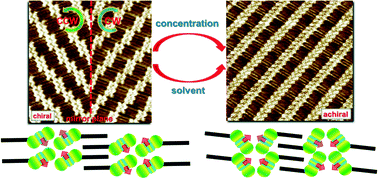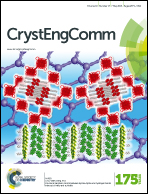Structural transition control between dipole–dipole and hydrogen bonds induced chirality and achirality†
Abstract
Nano-fabrication is an issue which has gained extensive attention in molecular engineering. Thus, we have probed intensively surface-based 2D self-assembly of 2-hydroxyanthraquinone (2-HA) derivatives by scanning tunneling microscopy (STM). During the STM process, two interesting nanostructures resembling closely Chinese knots and wheat were identified, thus they were denoted as Knot-like and Wheat-like patterns for legibility. Moreover, careful observation suggests that the Knot-like structure is chiral while the Wheat-like structure is achiral. Systematic analysis indicates that these two arrangements are mainly dominated by synergistic forces of dipole–dipole and hydrogen bonding interactions. To the best of our knowledge, the dipole induced chirality and achirality have been rarely reported, and the synergistic forces of dipole–dipole and hydrogen bonding interactions on dominating 2D assembly have never been proposed. In addition, structural transition between the Knot-like and Wheat-like configurations can be regulated by concentration and solvent as the alkyl chain length changes. Note that the phase transformation is in most cases incomplete. A summary of surface coverage for 2-HA-OCn (n = 12, 14, 16, 18, 20) molecules shows the general trend that a Knot-like structure is preferred in polar solvents and under low concentration, while a Wheat-like structure takes priority in nonpolar solvents and under high concentration. Besides, 2-HA-OCn (n = 11, 13, 15, 17) molecules adopted a Wheat-like pattern which differs from the Wheat-like pattern in the relative orientation of adjacent ribbons, attributed to a minimum of steric repulsion between the interdigitated alkyl chains. This study presents efficient strategies for the manipulation of chiral and achiral nanostructures, and the results are believed to be of significance to the fields of 2D self-assembly and interface science.


 Please wait while we load your content...
Please wait while we load your content...